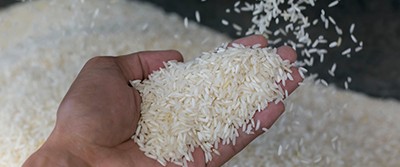Bioengineering Process Leads to Higher Rice Crop Yield

By Kevin Ritchart
A new bioengineering process that boosts photosynthesis in rice plants could increase yield by up to 27 percent, according to a new study. This new approach, known as GOC bypass, enriches the cells of rice plants with carbon dioxide (CO2) that would otherwise be lost through the metabolic process of photorespiration.
The genetically engineered plants were greener and larger than their non-GOC bypass counterparts and also showed increased photosynthetic efficiency and productivity, especially when subjected to bright light.
Bioengineering improvement of rice, a staple food crop in many parts of the world, is important particularly because of the need for increased crop productivity in response to world population growth and the reduction of cultivable soils. But increases in yield for rice and several other major crops have been sparse in recent years, and the crop yield is reaching its limit.
“Food shortage related to world population growth will be a serious problem our planet will have to face,” said Xin-Xiang Peng of South China Agricultural University in Guangzhou, China. “Our study could have a major impact on this problem by significantly increasing rice yield, especially for areas with bright light.”
Photosynthesis is the biochemical process during which CO2 and water are converted into oxygen (O2) and sugar compounds that are the basis for plant growth. One way to ramp up photosynthesis is to bypass photorespiration, a light-dependent process in which O2 is absorbed and CO2 released.
Abolishing photorespiration could result in up to a 55% increase in photosynthesis, allowing photorespiration to be the focus in improving photosynthetic efficiency and yield.
In recent years, three photorespiratory bypasses have been introduced into plants, and two of them led to measurable increases in photosynthesis and biomass yield. But most of the experiments were carried out using the model organism Arabidopsis, and the recorded increases were typically observed under environment-controlled, low-light, and short-day conditions.
“To the best of our knowledge, our study is the first that tested photorespiration bypass in rice,” said study co-author Zheng-Hui He of San Francisco State University.
The new study involved a strategy to divert CO2 from photorespiration to photosynthesis. Researchers converted a molecule called glycolate, which is produced via photorespiration, to CO2 using three rice enzymes: glycolate oxidase, oxalate oxidase, and catalase. To deploy GOC bypass, which was named for the three enzymes, genes encoding the enzymes were introduced into rice chloroplasts (organelles where photosynthesis takes place in plant cells).
GOC plants were consistently greener and larger, with an above-ground dry weight that was 14 to 25 percent higher than their non-genetically engineered counterparts. Additionally, starch grains doubled in size and increased in number per cell by 37 percent. In the spring seeding season, grain yield improved by 7 to 27 percent.
Researchers plan to optimize the performance of the GOC bypass-engineered plants by including the same bypass in other rice varieties. They would also like to apply the same approach to other crops like potatoes.
“Our engineered plants could be deployed in fields at a larger scale after further evaluations by independent researchers and government agencies,” Peng said.
Discussion Questions
- What natural factors have positive effects on the size and overall health of crops? What factors have negative effects?
- Other than rice and potatoes, what other crops do you think could thrive from the use of GOC bypass?
Vocabulary
- Photosynthesis
- Photorespiration
- Chloroplasts
- Organelles